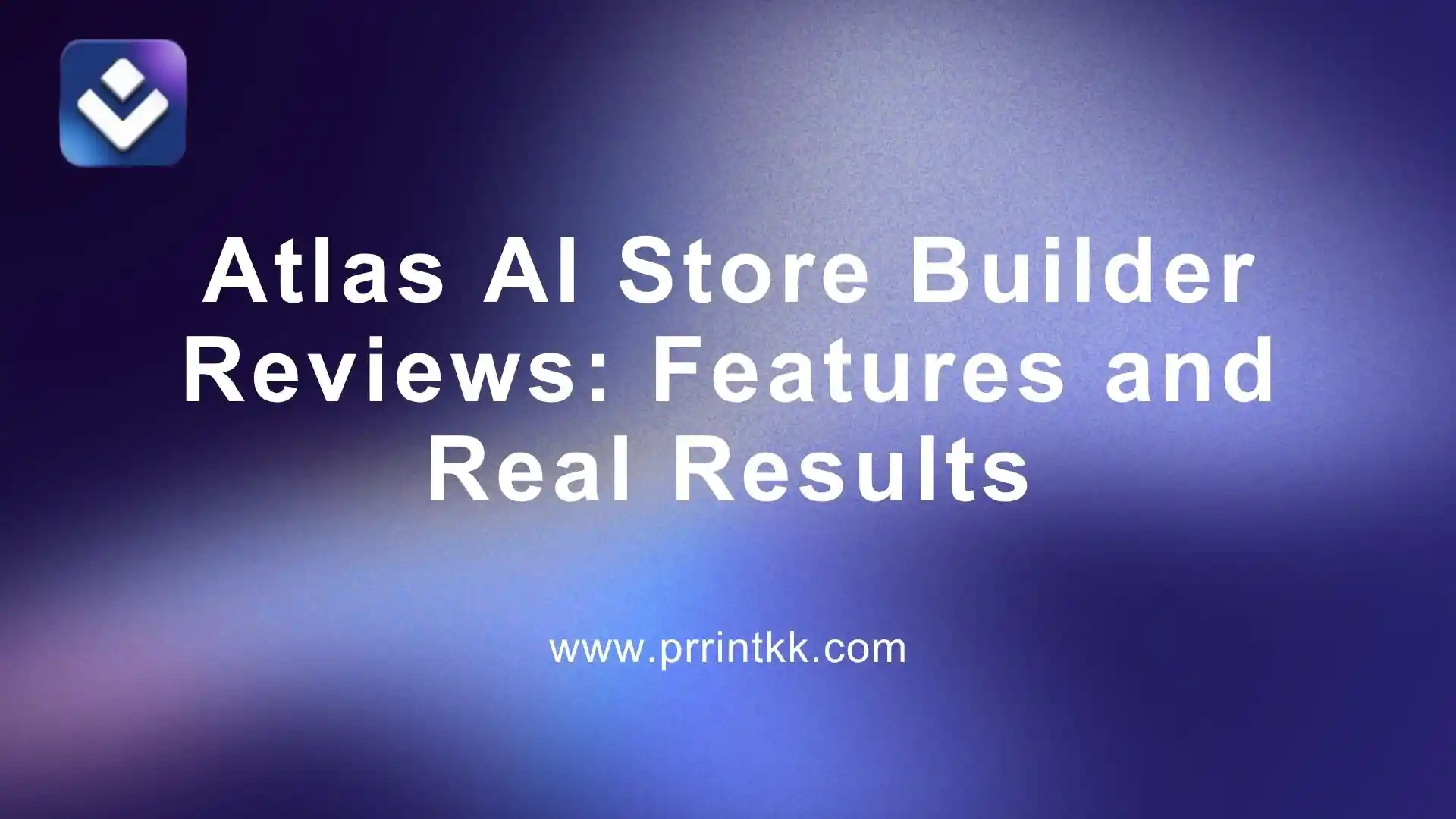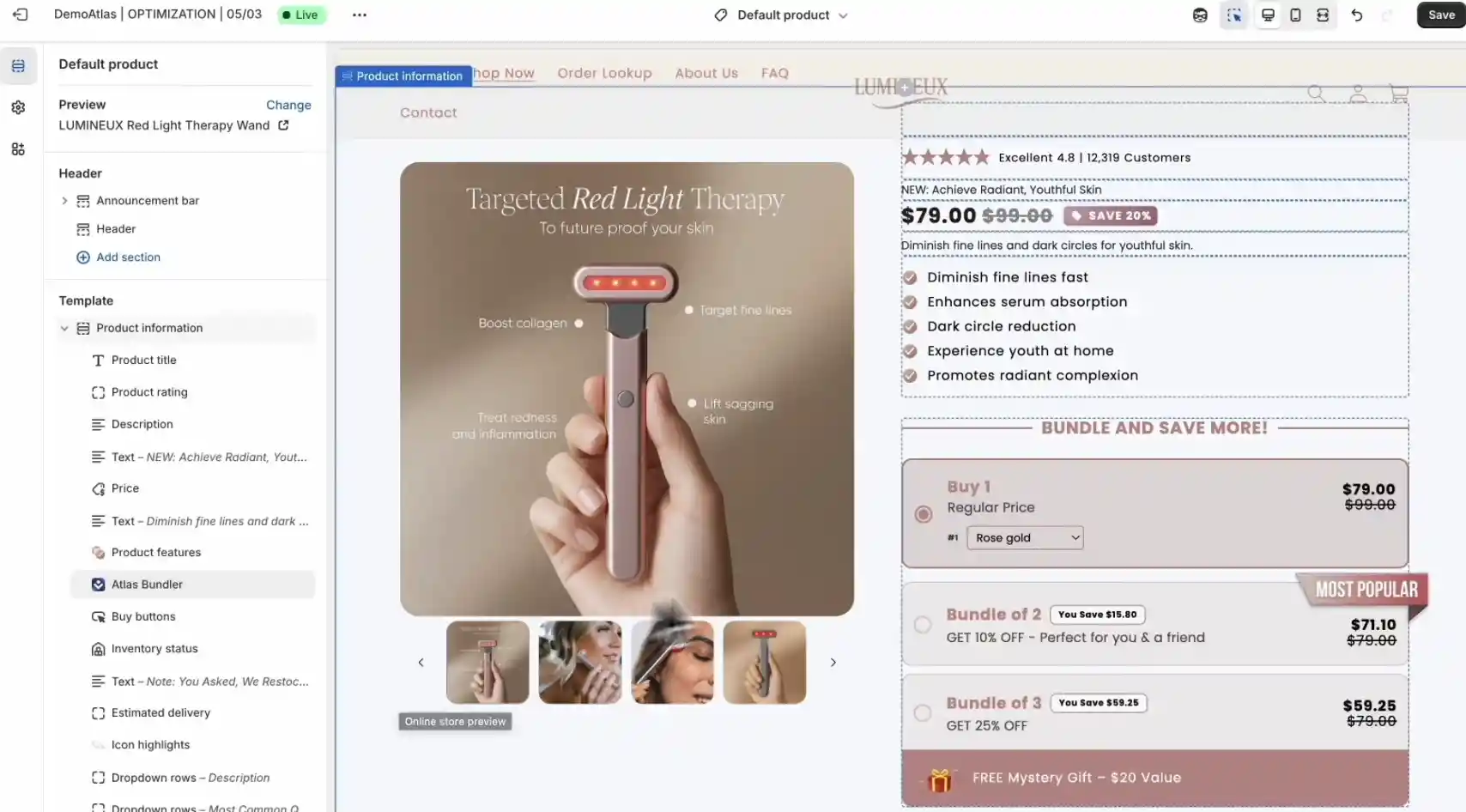
Launching an online store can feel overwhelming, especially with so many tools promising to simplify the process.
One solution gaining attention is Atlas AI Store Builder, a platform that claims to help entrepreneurs, artists, and brands create professional e-commerce stores quickly.
In this review, we'll break down its features, explore real-world results, and help you decide if it's the right fit for your business goals.
What is Atlas AI and Who Should Use?
What is Atlas AI
Atlas AI Store Builder is an AI-powered platform designed to help you create Shopify stores quickly. It uses artificial intelligence to generate product listings, design layouts, and even write product descriptions.
You don't need coding skills or a background in web design to get started. The platform also provides templates and automated tools to make store setup faster.
Essentially, Atlas AI is a tool that handles many of the repetitive tasks involved in launching an online store, letting you focus on choosing products and marketing.

Who Should Use
You should consider using Atlas AI if you:
- Are new to e-commerce and want a simple way to start a Shopify store.
- Don't have technical skills but want a professional-looking online shop.
- Run a small business and need to save time on product listings and store setup.
It is useful if you want to test product ideas quickly without spending weeks building a store from scratch.
Atlas AI Store Builder: Full Features
Easy Store Setup
If you want to get your store running quickly, Atlas AI Store Builder can save you hours. You pick a template, drop in your products, and adjust settings as you go.
You don't need to know any code, but you still get control over layout and navigation. The process is fast enough to test ideas without committing too much time.
AI-Powered Product Suggestions
One of the most useful features is the AI product recommendations.
Instead of guessing which products will sell, the AI highlights items that match your niche and current trends.
You can filter by price, category, or supplier reliability. This helps you avoid stocking products that won't move.
Customizable Store Design
You don't have to follow the default layout. Atlas lets you adjust colors, fonts, banners, and sections with a drag-and-drop editor.
Even small changes like button placement or product image size can affect sales, so having control here matters more than it looks.

Integrated Payment Options
Setting up payments is usually tricky, but this tool keeps it simple.
You can connect PayPal, Stripe, or credit cards, adjust currencies, and set tax rules without extra plugins.
That means your customers can check out quickly, and you won't spend hours troubleshooting transactions.
Automated Order Management
Once orders start coming in, Atlas keeps everything organized.
Order updates, tracking numbers, and notifications happen automatically. You don't need to log in constantly to check status, which frees time for marketing or sourcing new products.
Analytics and Reporting
Data is only useful if you can act on it. Atlas shows which products are selling, revenue trends, and customer behavior.
You can spot underperforming items fast and adjust pricing or marketing. Knowing where attention is needed helps your store grow more efficiently than guessing.
How to Use Atlas AI?
Step 1: Sign Up and Connect Your Shopify Store
Start by creating an account on Atlas AI and linking your Shopify store.
Connecting the two means you don't have to manually upload products or adjust layouts later. Spend a few minutes here to check your Shopify settings—if something is off, it's easier to fix now than after your store is live.

Step 2: Pick a Template That Fits Your Products
Atlas AI comes with ready-made templates. Don't just pick the prettiest one—look for templates that match your product type.
A template with too many features can slow your store down, while a simple one might convert better. Think about the flow your customers will experience, not just the colors.
Step 3: Add Products with AI Help
Instead of manually writing hundreds of product descriptions, use Atlas AI to generate them. You can:
- Upload a CSV of your products
- Let the AI write titles and descriptions
- Auto-optimize images
Focus on checking for accuracy and tone. AI saves time, but small tweaks make products feel real and trustworthy.

Step 4: Fine-Tune for Your Brand
After AI does the heavy lifting, go through your store. Adjust layouts, update product details, and add your own touch.
Even minor customizations—like changing a headline or swapping an image—can make the store feel unique.
Step 5: Launch and Watch the Data
Once live, don't set it and forget it. Check which products get clicks, which pages hold attention, and which descriptions need improvement.
Data drives decisions here. A small tweak today can boost conversions tomorrow.
The Hidden Details That Drive Shopify Conversions
Most Shopify stores fail not because the products are bad, but because small details block conversions.
Things like trust, visuals, structure, and clarity make the difference between a store that looks okay and one that actually sells. Here's what to focus on:
Clean and Consistent Design
A simple and consistent design builds instant trust. Stick to two main colors and the same font style across all pages. Keep plenty of white space — clutter makes visitors leave fast.
Clear design helps customers focus on your product and makes your store look professional.
Show Real Trust Signals
Shoppers only buy when they feel safe. Place badges for Free Shipping or Free Returns near your "Add to Cart" button.
Display secure payment icons like Visa or PayPal. Show real reviews and photos from past customers. Each of these trust cues reduces hesitation and nudges visitors to buy.
Product Photos That Tell a Story
Images sell better than text. Start with a white-background image, then add detail shots and photos showing the product in real life.
Keep image quality consistent for all products. Good visuals let your customers imagine owning the product — that's when they click "Buy."
Simple, Benefit-Focused Descriptions
People want solutions, not specs. Explain how your product makes life easier. Use short sentences, bullet points, and clear headings.
End with a simple call to action, like "Try it today." Easy-to-read descriptions keep people scrolling and increase cart adds.

Smart Offers, Not Fake Urgency
Avoid fake countdowns or "only 3 left" tricks. Instead, offer real bundle deals, show limited stock only when true, and highlight the best-value options clearly.
Honest, well-structured offers build trust and encourage bigger purchases.
Mobile Experience Matters
Over 70% of Shopify sales happen on phones. Make sure pages load fast and buttons are easy to tap.
Simplify checkout — fewer steps mean fewer drop-offs. Keep text short and readable on small screens. A smooth mobile experience can turn casual scrollers into buyers.
Atlas AI Store Builder Review: Worth It or Waste of Time?
Using AI to build a Shopify store can save you a lot of time, but you might wonder if it really works for a full business. Some people worry that AI tools can't handle product variants, custom layouts, or checkout flows, and that's a valid concern.
From what users share, the experience varies. Many found that AI builders can create a functional store very quickly.
One user said they spent weeks coding their first store manually, paying $3,000 and hiring help, while the AI tool built a better-looking store in just a couple of minutes. Product photos, bundles, and upsells were already included, which made it feel ready to launch.
Another point is customization. Some AI platforms, like Atlas, allow you to adjust layouts, manage product variants, and keep checkout smooth. You're not stuck with a generic demo site—you can start with a working base and make it your own.
In short, these tools are worth trying if your goal is to save setup time and get a store running quickly.
They may not replace careful planning and ongoing tweaks, but they can definitely give you a solid starting point without the stress of building everything manually.
Expert Tips
The Atlas AI Store Builder gives you the tools to create a professional store without complicated setup. You can customize designs, add products, and track performance easily.
Small details, like clear layouts and trust signals, make a big difference in sales. By paying attention to visuals, descriptions, and checkout flow, you can improve how customers interact with your store. You don't need to be an expert to use it effectively.
Overall, Atlas AI Store Builder helps you focus on what matters — your products and your customers — while giving your store a clean, functional, and professional look.
FAQs
Is Atlas AI Store Builder free?
Atlas AI Store Builder isn't fully free, but it offers trial options so you can explore the features before paying. You can test templates, AI product suggestions, and basic store setups without committing immediately.
Is Atlas AI Store Builder good?
Many users find it useful for saving time and simplifying store setup. It handles product variants, layouts, and checkout smoothly, giving you a ready base to customize and start selling faster than manual builds.
Can I start a Shopify store with no money?
Starting a Shopify store without upfront costs is possible using free trials, basic plans, and dropshipping suppliers. You may need to invest eventually, but the platform lets you experiment and learn without major initial expenses.
Can I make $10,000 per month dropshipping?
Making $10,000 a month is possible but depends on product choice, marketing, and consistent effort. Dropshipping can grow steadily, but results vary and require testing, optimization, and careful planning to reach higher income levels.










 Global Shipping
Global Shipping





























